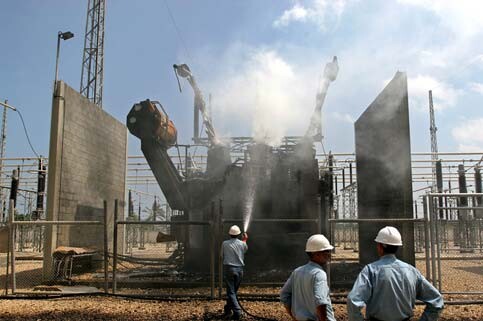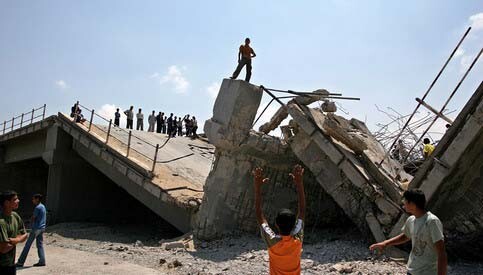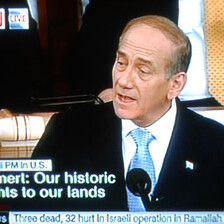The Electronic Intifada 6 July 2006
One needed only to watch the interview on British television this week with Israel’s ambassador to the UK to realise that the Israeli army’s tightening of the siege on Gaza, its invasion of the northern parts of the Strip today, and the looming humanitarian crisis across the territory, have nothing to do with the recent capture of an Israeli soldier — or even the feeble home-made Qassam rockets fired, usually ineffectually, into Israel by Palestinian militants.
Under questioning from presenter Jon Snow of Channel Four news on the reasons behind Israel’s bombing of Gaza’s only power station — thereby cutting off electricity to more than half of the Strip’s 1.3 million inhabitants for many months ahead, as well as threatening the water supply — Zvi Ravner denied this action amounted to collective punishment of the civilian population.
Rather, he claimed, the electricity station had to be disabled to prevent the soldier’s captors from having the light needed to smuggle him out of Gaza at night. It was left to a bemused Jon Snow to point out that smugglers usually prefer to do their work in the dark and that Israel’s actions were more likely to assist his captors than disadvantage them.
The Alice Through the Looking Glass quality of Israeli disinformation over the combined siege and invasion of Gaza — and its widespread and credulous repetition by the Western media — is successfully distracting attention from Israel’s real goals in this one-sided war of attrition.
The current destruction of Gaza’s civilian and administrative infrastructure is reminiscent of the Israeli army’s cruel rampages through the streets of West Bank cities in the repeated invasions of 2002 and 2003, and the Jewish settlers’ malicious attacks on Palestinian farmers trying to collect their olive harvests.
The relative absence of these horror stories today is simply a reflection of the terrible success of the wall Israel has built across Palestinian farmland and around Palestinian population centres in the West Bank. Settlers no longer need to plunder the olive harvest when the fruit is being left to rot on the trees because farmers can no longer reach their groves.
In the case of the West Bank invasions, Israeli tanks rolled easily into Palestinian cities that had already been isolated and crippled by the stranglehold of checkpoints and roadblocks all over the territority. Israeli heavy armour knocked down electricity pylons as though they were playing a game of ten-pin bowling, snipers shot up the water tanks on people’s roofs, soldiers defecated into office photocopiers and the army sought out Palestinian ministries so that their confidential records and documents could be destroyed or stolen.
Notably, only in the warren of alleys in the overcrowded refugee camps of Jenin and Nablus did the army find the going far tougher and suffer relatively high casualties.
Which may explain the military caution that has been exercised by Prime Minister Ehud Olmert in regard to the ground invasion of Gaza. The tiny Strip, besieged on its land borders by the Israeli army behind an electronic fence and on the seafront by the Israeli navy, is one giant, overcrowded refugee camp. The past week has seen Gaza “softened up” with airstrikes on its infrastructure and government ministries. Today, land forces began wreaking more death and destruction — fourteen killed at the time of writing — in “mopping up” exercises in the pattern established earlier in the West Bank.
Three long-standing motives are discernible in Israel’s current menacing of Gaza.
First, Israel is determined to continue its campaign of impairing the Palestinian Authority’s ability to govern. This has nothing to do with the recent election of Hamas to run the Palestinian Authority. Israel’s official policy of unilateralism — ignoring the wishes of the Palestinian people — began long before, when Yasser Arafat was in charge. It has continued through the presidency of Mahmoud Abbas, a leader who is about as close to a quisling as Israel is likely to find.
Hamas’s electoral success has merely supplied Israel with the pretext it needs for launching its invasion and the grounds for demanding international support as it chokes the life out of Gaza. Israel doubtless hopes that at the end of this process it will be left with Abbas, a figurehead president backed into a corner and ready to put his name to whatever agreement Israel imposes.
Second, the attack on Gaza — as ever — is partly a distraction from the real battle. It was widely recognised that Ariel Sharon’s dogged pursuit of his Gaza disengagement policy last year was designed to free his hand for the annexation of large chunks of a greater prize, the West Bank, and for securing the biggest prize of all, East Jerusalem. Nothing has changed on this front.
As Israel keeps all eyes directed towards the suffering in Gaza, it is starting to make significant moves in the West Bank and Jerusalem.
It is preparing for the much-delayed evacuation of a handful of illegal West Bank hilltop settlements — known in Israel as “outposts” — demanded as the first stage of the implementation of the almost-forgotten US-sponsored peace process called the Road Map.
These outposts are tiny, often just a few caravans. It will be much to Israel’s advantage if the world fails to examine too closely the miserly act of evacuating these places, which doubtless will later be presented both as Israel having made a huge sacrifice for peace and as having satisfied its side of the Road Map’s conditions.
The loss of these outposts and a few larger settlements will pave the way for international acceptance of Olmert’s convergence plan, his unilaterally imposed expansion of Israel’s borders at the expense of a viable Palestinian state.
Equally significant are the overlooked manoeuvres Israel is undertaking in East Jerusalem as it beats a warpath towards Gaza. Last week Israel stripped four Hamas MPs of their right to live in East Jerusalem, effectively expelling them to the West Bank. It also showed that it could lock up them and dozens of other democratically elected Palestinian representatives with barely a peep from the international community.
In yet another dose of Alice in Wonderland, Israel’s policy of making hostages of these MPs was referred to as “arrests” by the Western media. Few bothered to report that the MPs are being deprived of even their most basic rights, such as meeting with their lawyers.
As the four Jerusalem MPs’ lawyers have argued, it is a nonsense that Israel allowed these Hamas politicians to stand in the recent elections and now, after their victory, it calls their membership of the party “support for terrorism”. It is also a disturbing sign of how easily Israel will be able to begin ethnically cleansing East Jerusalem of its Palestinian inhabitants using the flimsiest of excuses.
And third, and perhaps most significantly of all, Israel is using the siege and invasion of Gaza as a laboratory for testing policies it also intends to apply to the West Bank after convergence. Gazans are the guinea pigs on which Olmert can try out the “extreme action” he has been boasting of.

Palestinian electricity workers extinguish a fire inside the headquarters of the main electricity company in the Gaza Strip after it was attacked by an Israeli missile during air strikes over the city, June 28, 2006. (MaanImages/Wesam Saleh)
The destruction of Gaza’s power plant and loss of electricity to some 700,000 people; the consequent scarcity of water, build-up of sewage that cannot be disposed of, and inevitable spread of disease; the shortages of fuel and threats to the running of vital services such as hospitals; the sonic booms of Israeli aircraft that terrify Gaza’s children and unpredictable air strikes that terrify everyone; the inability of Palestinian officials to run bombed ministries and provide services; the constant threat of invasion by massed Israeli troops on the “border”; and the breakdown of law and order as Fatah and Hamas gunmen are encouraged to turn on each other. All these factors are designed to one end: the slow demand by Palestinians, civilians and militants alike, to clear out of the hell-hole of Gaza.

Palestinians inspecting a bridge destroyed by Israeli army warplanes in the northern Gaza Strip, June 28, 2006. (MaanImages/Wesam Saleh)
The traffic through the tunnels that once served Gaza’s smugglers will change directions: where once cigarettes and arms came into Gaza, the likelihood is that soon it will be people passing through those underground passages to leave Gaza and seek a life outside.
If this experiment in human despair works in the small Gaza Strip, its lessons can be applied to much bigger effect in the West Bank ghettoes left behind after convergence. This is how ethnic cleansing looks when it is designed not by butchers in uniforms but by technocrats in suits.
Related Links
Jonathan Cook, based in Nazareth, is the author of Blood and Religion: The Unmasking of the Jewish and Democratic State, published by Pluto Press and available in the US from University of Michigan Press. His website is www.jkcook.net.





